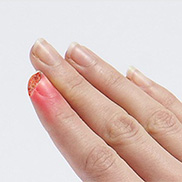Fingertip Injuries

What is a Fingertip Injury?
A fingertip injury is a wound or damage caused to the most distal portion of the finger. It can be a crush, a sharp cut, a tear or a combination of these, and can result in damage to the skin, nail or nailbed, tendon, pulp, bone, and nerve endings. It is one of the most common injuries to the hand and may occur due to accidents at home, work, or play.
What are the Types of Fingertip Injuries?
Pain and swelling to the fingertip coupled with bleeding are the general symptoms of a fingertip injury. Some of the common types of fingertip injuries include:
- Subungual hematoma: Throbbing fingertip, nail discoloration, bleeding beneath the nail
- Nail bed laceration: Active bleeding with painful fingertip, grossly deformed nail with visible nail fracture
- Mallet finger: Drooping, painful, and swollen fingertip
- Distal phalanx fracture: Painful and swollen fingertip, damage to finger pulp
- FDP avulsion (“jersey finger”): Swollen, painful finger especially at the volar distal interphalangeal joint (DIPJ)
- DIPJ dislocation: Painful and swollen fingertip
What If the Condition is Left Untreated?
If left untreated, fingertip injuries can result in:
- Permanent disability
- Loss of fingertip or nail
- Finger deformity or disability
- Paresthesias (abnormal sensation)
- Hand function impediment
How are Fingertip Injuries Diagnosed?
Generally, your doctor will examine your fingertip and look for exposed bone, missing tissue and injury to the nail or nailbed. The doctor may further assess the sensation of the fingertip and check its mobility. You may be asked about your medical history and circumstances of the injury (how it occurred). An x-ray may be taken to see if the bone is injured or broken and to determine the type of fingertip injury.
How are Fingertip Injuries Treated?
Treatment of a fingertip injury normally depends on its severity. In cases of minor crushing of the fingertip, a simple dressing may work. The area may need to be drained to reduce hematomas. A splint or temporary metal pins may be required to treat broken fingertip bones. Amputation of the fingertip may be necessary if the damage is too severe. Certain fingertip injuries may also require specialized surgical treatments including skin grafting, reconstructive flap surgery or replantation.
Related Topics:
- Carpal Tunnel Syndrome
- Wrist Fracture
- Trigger Finger
- Hand Injuries
- Fingertip Injuries
- Wrist Injuries
- Fractures of the Hand and Fingers
- Thumb Fracture
- Scaphoid Facture
- Adult Forearm Fractures
- Forearm Fractures in Children
- Arthritis of the Hand and Wrist
- Arthritis of the Thumb
- Wrist Sprain
- Finger Sprain
- Finger Dislocation
- Hand Pain
